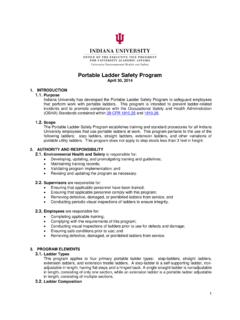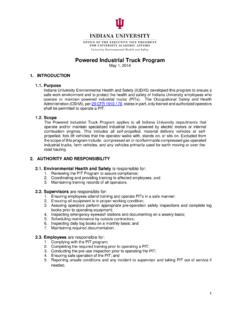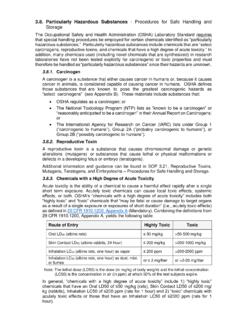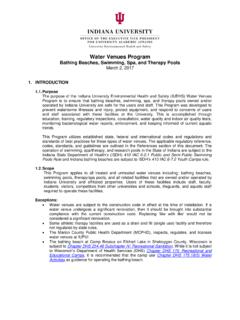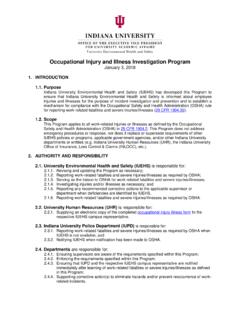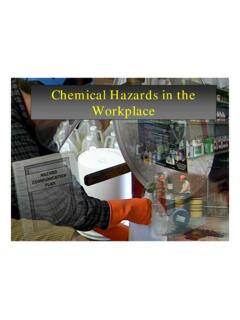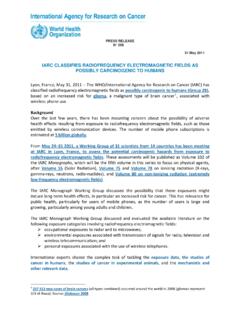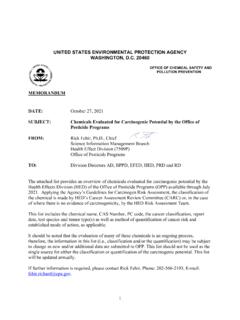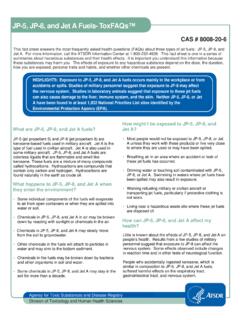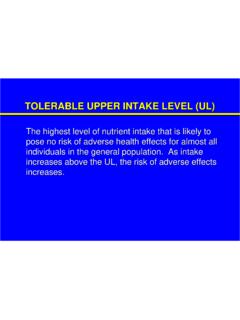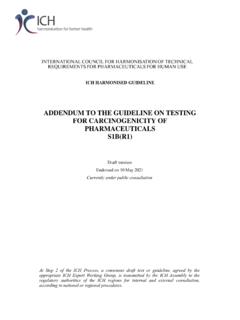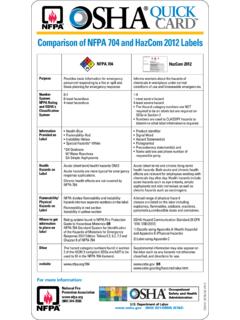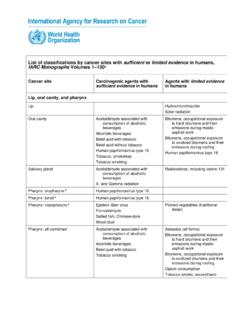Transcription of 3.2. Procedures for Proper Labeling, Storage, and ...
1 Procedures for Proper Labeling, Storage, and Management of Chemicals Proper chemical labeling and storage is essential for a safe laboratory work environment. Inappropriate storage of incompatible or unknown chemicals can lead to spontaneous fire and explosions with the associated release of toxic gases. To minimize these hazards, chemicals in the laboratory must be segregated properly. The storage Procedures listed below are not intended to be all-inclusive but should serve instead to supplement more specific Procedures and recommendations obtained from container labels, Safety Data Sheets (SDSs), and other chemical reference material.
2 For more information about chemical storage contact the University Environmental Health and Safety for your respective campus. (see Laboratory Safety Contacts). Labeling Manufacturer chemical labels must never be removed or defaced until the chemical is completely used. All chemical and waste containers must be clearly labeled with the full chemical name(s) (no abbreviations or formulas) and must contain appropriate hazard warning information. Small containers that are difficult to label such as 1-10 ml vials and test tubes can be numbered, lettered, or coded as long as an associated log is available that identifies the chemical constituents.
3 Groups of small containers can be labeled as a group and stored together. Unattended beakers, flasks, and other laboratory equipment containing chemicals used during an experiment must be labeled with the full chemical name(s). All chemicals should be labeled with the date received and date opened. All laboratory chemical waste containers must be labeled with the name of the chemicals contained. All full waste containers must be disposed of promptly. Waste containers must NOT be filled to more than 90% of their capacity). All chemical storage areas such as cabinets, shelves and refrigerators should be labeled to identify the hazardous nature of the chemicals stored within the area ( , flammables, corrosives, oxidizers, water reactives, toxics, carcinogens, and reproductive toxins).
4 All signs should be legible and conspicuously placed. Safety Data Sheets Safety Data Sheets (SDS) for all laboratory chemicals are required to be maintained in the laboratory or on-line. Safety Data Sheets are available from manufacturer s web sites and through the MSDSO nline service at the IUEHS website, The SDS for the exact chemical or mixture provided by the manufacturer of the product must be available. The chemical identity and manufacturer found on the label must match the chemical identity and manufacturer found on the SDS. All personnel must know how to access the SDS whether they are maintained on paper or electronically.
5 All personnel must know how to read and understand an SDS. Additional guidance on how to read, understand, maintain and (if necessary) prepare a Safety Data Sheet is available from EHS for your respective campus. Storage HAZARD GROUPS Flammable/Combustible Liquids Unstable (shock-sensitive, explosive) Flammable Solids Carcinogens & Reproductive Toxins Inorganic Acids Toxins, Poisons Organic Acids Non-Toxics Oxidizing Acids (Nitric, etc.) Gases: Caustics (Bases) Toxic Gases Oxidizers Flammable Gases Water Reactives Oxidizing Gases Air Reactives Corrosive Gases Inert Gases A defined storage place should be provided for each chemical and the chemical should be returned to that location after each use.
6 Chemical containers must be in good condition before they are stored. Containers must be managed to prevent leaks. Maximum quantities of chemicals that can be in storage and use in laboratories are found in the Uniform Building Code1, the Uniform Fire Code2, the International Building Code3 and International Fire Code4. The tables maximum allowable quantities are found in Appendix B. These codes place specific quantity limits on storage of chemicals in all hazard classes and some are very low, such as those for highly toxic gases and organic peroxides. Chemicals (including waste) must be separated and stored according to their hazard group and specific chemical incompatibilities.
7 Chemicals within the same hazard group can be incompatible, therefore, it is important to review the chemical label and Safety Data Sheet (SDS) to determine the specific storage requirements and possible incompatibilities. Appendix B contains a partial list of incompatible chemicals. Special attention should be given to the storage of chemicals that can be classified into two or more hazard groups. For example, acetic acid and acetic anhydride are both corrosive and flammable. In addition, nitric and perchloric acids are both corrosive and strong oxidizers. Separate organic acids from oxidizing acids using secondary tubs or trays in the corrosives cabinet.
8 Refer to the Safety Data Sheet (SDS) for Proper storage Procedures . Chemicals should be separated by distance. Physical barriers such as storage cabinets and secondary containers should be used to prohibit contact of incompatible chemicals in the event that they are accidentally released or spilled. Secondary containers are highly recommended for the storage of liquid chemicals. Secondary containers must be made of a material that is compatible with the chemical(s) it will hold and must be large enough to contain the contents of the largest container.
9 Liquids should not be stored above dry chemicals unless they are stored in secondary containers. Storage of chemicals within hoods and on bench tops should be avoided. Stored chemicals should not be exposed to heat or direct sunlight. Storage shelves and cabinets should be secure to prevent tipping. Shelving should contain a front-edge lip or doors to prevent containers from falling. Flammable and corrosive storage cabinets should be used when possible. Flammable liquids in quantities exceeding a total of 10 gallons in each laboratory must be stored in an approved flammable storage cabinet.
10 Only explosion-proof or laboratory-safe refrigerators may be used to store flammable liquids. Liquid chemicals should be stored below eye level to avoid accidental spills. Chemicals must not be stored in areas where they can be accidentally broken and spilled such as on the floor or on the edge of a bench top. Chemicals must not be stored in areas where they obstruct aisles, exits, and emergency equipment. Chemical Inventory Management All reportable chemicals must be inventoried. A list of reportable chemicals can be found at IUEHS. In addition to reportable chemicals, all chemicals should be inventoried.
